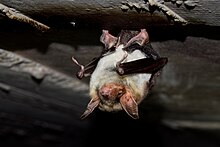
Myotinae is one of the four subfamilies of Vespertilionidae, itself one of twenty families of bats in the mammalian order Chiroptera and part of the microbat suborder. A member of this subfamily is called a myotine, or a vesper bat. They are found in all continents besides Antarctica, primarily in forests and caves, though some species can also be found in shrublands, grasslands, rocky areas, or deserts. They range in size from the Taiwan broad-muzzled bat, at 3 cm (1 in) plus a 3 cm (1 in) tail, to the large myotis, at 10 cm (4 in) plus a 6 cm (2 in) tail. Like all bats, myotines are capable of true and sustained flight, and have wing lengths ranging from 2 cm (1 in) to 7 cm (3 in). They are all insectivorous and eat a variety of insects and spiders,[1] but some bats with long toes which trawl for insects on top of the water, such as the long-fingered bat Daubenton's bat, Maluku myotis, Rickett's big-footed bat, and pond bat, may sometimes supplement their diet with small fish from still waters. The fish-eating bat also regularly eats fish and crustaceans as well as insects, and is the only bat species that hunts fish in the ocean.[2] Almost no myotines have population estimates, though seven species—the Atacama myotis, eastern small-footed myotis, Findley's myotis, flat-headed myotis, frosted myotis, little brown bat, and peninsular myotis—are categorized as endangered species, and two species—the Nimba myotis and Yanbaru whiskered bat—are categorized as critically endangered.
The 121 extant species of Myotinae are divided between three genera: Eudiscopus and Submyotodon with one species each, and Myotis, or the mouse-eared bats, with the other 119. A few extinct prehistoric myotine species have been discovered, though due to ongoing research and discoveries the exact number and categorization is not fixed.[3]